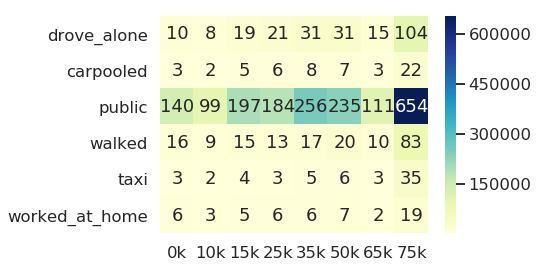Commuting Patterns
Analyzing US Census Data in Python

Lee Hachadoorian
Asst. Professor of Instruction, Temple University
Commuting Tables
Commuting Subjects
- Means of transportation (car, public transit, etc.)
- Travel time
- Time leaving for/arriving at work
Commuting Geographies
- Residence: where people sleep
- Workplace: where people work; can use to determine workforce population for county, tract, etc.
Congestion Pricing in New York City
- Currently being debated in NYC (early 2019)
- Previous attempt failed (2007)
- Concerns over cost for low- and middle-income households

1 Photo by Brian Jeffery Beggerly (CC BY 2.0)
Table B08519: Means Of Transportation To Work By Workers' Earnings In The Past 12 Months (In 2017 Inflation-Adjusted Dollars) For Workplace Geography
Total
$1 to $9,999 or loss
$10,000 to $14,999
$15,000 to $24,999
$25,000 to $34,999
$35,000 to $49,999
$50,000 to $64,999
$65,000 to $74,999
$75,000 or more
Car truck or van - drove alone
<repeat income categories>
Car truck or van - carpooled
<repeat income categories>
Public transportation (excluding taxicab)
<repeat income categories>
etc...
API Response
print(r.json())
[['B08519_011E', 'B08519_012E', 'B08519_013E', 'B08519_014E', 'B08519_015E',
'B08519_016E', 'B08519_017E', 'B08519_018E', 'B08519_020E', 'B08519_021E',
...
'B08519_061E', 'B08519_062E', 'B08519_063E', 'state', 'county'],
['10927', '9172', '19659', '22110', '32287',
'32977', '15693', '106972', '3663', '2518',
...
'7457', '2664', '20684', '36', '061']]
Reshaping the Data
# Read data row into list data_row = r.json()[1][:-2]# Break data row into list of lists iter_len = 8 data = [data_row[i:i+iter_len] for i in range(0, len(data_row), iter_len)]print(data)
[['10927', '9172', '19659', '22110', '32287', '32977', '15693', '106972'],
['3663', '2518', '5484', '5625', '8028', '7990', '3369', '22958'],
['139358', '97178', '200514', '184510', '255491', '240973', '116673', '700808'],
['16743', '9117', '15900', '13710', '17442', '20206', '10370', '85879'], ...]
Constructing the DataFrame
# Define row names and column names modes = ["drove_alone", "carpooled", "public", "walked", "taxi", "worked_at_home"]incomes = ["0k", "10k", "15k", "25k", "35k", "50k", "65k", "75k"]# Create DataFrame manhattan = pd.DataFrame(data=data, index=modes, columns=incomes) manhattan = manhattan.astype(int)
Constructing the DataFrame
print(manhattan)
0k 10k 15k ... 50k 65k 75k
drove_alone 10716 8965 19294 ... 31502 15519 104078
carpooled 3740 2451 5852 ... 7994 3438 22625
public 140957 99474 197241 ... 235158 111959 654800
walked 16795 9045 15451 ... 20704 10663 83681
taxi 3201 2209 4515 ... 6551 3029 35572
worked_at_home 6854 3885 5489 ... 7776 2809 19598
[6 rows x 8 columns]
Constructing the Heatmap
# Create heatmap of commuters by mode by income
sns.heatmap(manhattan, annot=manhattan // 1000, fmt="d", cmap="YlGnBu")

Let's practice!
Analyzing US Census Data in Python

